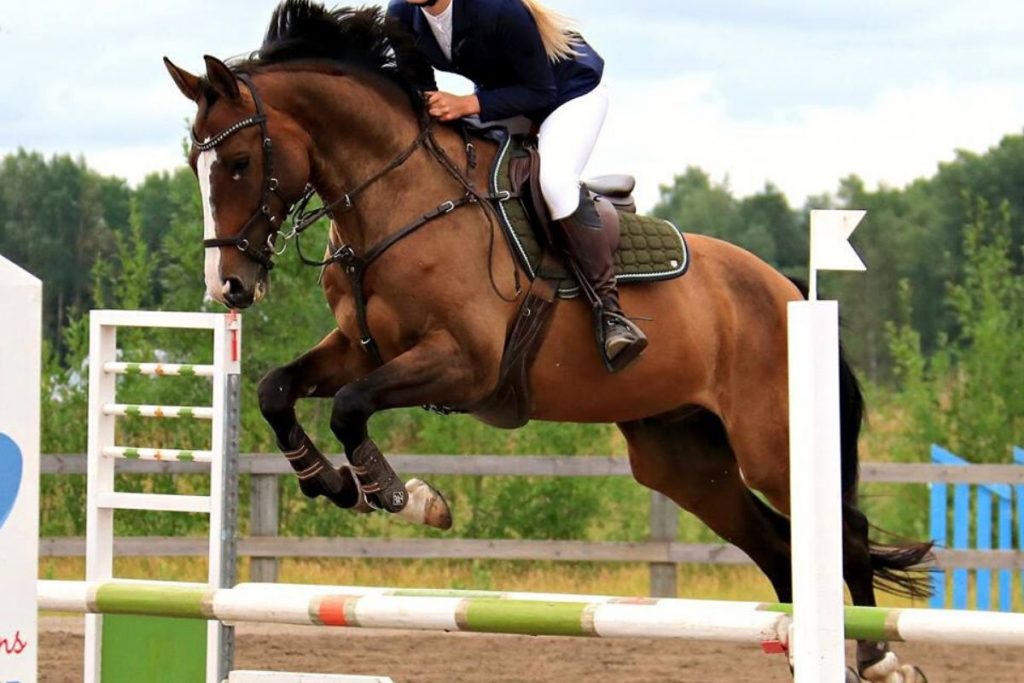Know how to measure jumps can be important whether you are creating your own practice jumps or preparing a jumping course. Two key measurements are the distance between the jumps and the height of the jumps. You must know to properly set jumps and walk a jumping course.
How to measure horse jumps: The distance between jumps is measured based on the average stride of the horse at a canter so that the rider will know how to collect and plan out the horse’s strides between jumps. Correctly measuring the height using the top rail allows the rider to train their horse and know its abilities.
Many beginning jumpers only focus on the height of the jumps wanting to master higher and higher jumps. But, knowing how to measure the distance between jumps is also an important skill for competing for jumping events. Each measurement gives the rider different information that can be used to successfully complete the course.
Measuring Distance Between Jumps

Many riders will often measure the distance between jumps by walking the course and counting their strides. Practical Horse Magazine gives directions on how to practice making your strides exactly 3 feet. Since a horse averages 12 feet per stride, using this method four people strides will equal exactly one horse stride. Since most people have a natural stride that is less than 3 feet, it does take practice.
When jumping, horses will take a half stride when taking off and landing. You need to deduct two strides after each jump and before the next jump to account for this. After doing this, divide the remaining stride count by 4 to know the number of horse strides between each jump. By keeping count, you will be able to identify the number of strides needed between jumps.
Using this method will identify any tricky areas where the stride count does not match the typical 12 feet stride. The rider will then know where to lengthen or shortened the horse’s stride when approaching jumps so that the horse takes the jumping stride at the appropriate place allowing for maximum height and jump clearance.
Combination Jumps
All riders eventually want to attempt a double or triple jump. With these jumps, it is important to measure not just the height of each jump, but the space between the jumps. Horse Answers Today states that the distance between two jumps for training depends on the following:
- The size of the jumps
- Your horse’s stride length
- The jumping ability/level of the horse
- The rider’s ability to maintain a good canter
When placing jumps, it is important to make sure you measure for a landing stride, a take off stride, and the number of strides between the two jumps. Combination jumps vary on level of difficulty, but often have one or no non-jump strides between the jumps. The total distance would be 24 feet if allowing one non-jumping stride measuring from the base of the first to the base of the second.
When your horse is ready, you can bring the two jumps closer together to eliminate the non-jumping stride. However, the jumps should never be less than 12 feet apart to allow for the landing and take off strides. It is important to remember this is based on average stride length and may need to be adjusted if your horse has longer or shorter stride length.
Canter Stride

It is important to remember that every horse’s canter stride does have some variation and counting stride will only indicate the needed strides. When jumping it is important to know what factors will change the stride length on the course. Factors can either lengthen or shortened the stride length.
- Factors that lengthen the stride:
- Downhill sloped terrain
- a higher basic speed
- springy footing/material of the course
- jumps facing the exit or warm up area
- Factors that shorten the stride
- Uphill sloped terrain
- Uneven footing
- a low basic speed
- Jumps facing away from the exit or warm up areas.
These factors need to be taken into consideration when walking the course and counting
Jumping Height
Measurements to Make Horse Jumps reports the most accurate way to measure the jump height is to measure from the top of the rail to the ground. The measurement should be taken in the center of the rail, where the horse will be jumping. This way avoids any potential inaccuracies from creeping into the measurements and gives the exact “true” height of the jump.
Height of the Drill Holes
The standards (vertical poles that hold the jumping rails) will have holes drilled approximately three inches apart. This allows for the top rail to be moved as needed. Cups, used to hold the rails, are screwed into each hole. Because the cups often sit below the hole, the top of the rail will be even with the holes. The height would be from the ground to the drill holes.
The main reason for this method is convenience. The standards are measured and marked when the jump is being made. The height of each placement is known to allow the rail to be moved as needed once the jump is in place without having to re-measure it each time. This can be very helpful for a practice jump being used by several different riders.
This method however is not as accurate as measuring the top rail every time because several factors can create measuring errors:
- Cups did not always place the top of the rail even with the drill hole.
- Rails are not always the same width
- The footing of the jump can vary changing.
All of this makes measuring the drill holes less accurate. To set an exact jump, using the measurement to the center of the top rail with a measuring tape is needed.
Remember: The height of the jump does not measure how high the horse cleared it, meaning your horse may have jumped much higher than the recorded height.
Jump Width
Practical Horseman Magazine discussed one area that is often overlooked when measuring fences. Their article on “skinny fences” discusses the difficulty of jumps based on the width of the jump. Most jumps are a standard 12 feet wide, allowing the rider a larger target area. However, some advanced jumping courses and eventing has started using “skinny” fences that can be as small as 5 ½ feet wide.
These jumps will seem no harder than any other jump of similar height, but can be easily to miss if a direct approach is not used. Riders need to be able to know the measurements in order to know how direct their approach line will be.
The width of jumps can be measured using just the jumping area. Start at the edge of the standard that has the rail cups and measure straight across to the edge of the opposite standard. A tape measure can be used when making or measuring practice fences. When walking a jumping course, the width can be measured in strides just like the distance between the fences.
Final Thoughts
When jumping, it is important to measure correctly several factors, not just the height of the jumps. When setting up practice fences, the easiest and most accurate way is using a tape measure. However, when riders walk a jumping course, they do not have this ability. Learning a perfect 3 foot stride will allow riders to measure distance between jumps and the width of jumps when walking the course.
